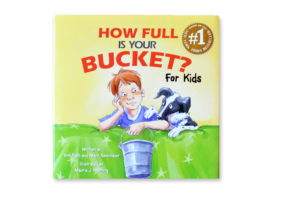Illustration by Megan Sapelak
Have you ever noticed that when you’re feeling down, every little thing starts to feel monumentally disastrous? On the flip side, when life feels good, small inconveniences seem to roll by with barely a second glance. This applies to us adults, and, while they might not express it, it applies equally to our children.
Enter the bucket metaphor.
In Tom Rath and Mary Reckmeyer’s book “How Full is Your Bucket? For Kids,” they introduce the concept that everyone has an invisible bucket above their heads that is either filled or emptied with the events of the day. For example, a sibling skirmish would leak drops of water while a compliment from a teacher would add to the bucket. Since we never know how full or empty someone’s bucket is at any given moment, we must do our best to positively contribute to someone else’s bucket. The fuller the bucket, the better equipped we are to handle life’s ups and downs.
In this book, we follow Felix throughout the day and his understanding of how events and comments can impact bucket levels. He understands how small, kind gestures can make a positive difference in the lives of others. He also witnesses how short, angry comments said in the heat of the moment can take away from the bucket’s level.
Introducing this concept to young children helps provide them with a visual illustration of how we impact others with our actions. Whether intentional or accidental, we are always influencing the way those around us feel. This book teaches us how to be intentional with our words and actions to create a happier environment. It also teaches children how to fill their own bucket when it starts getting low. Before reaching empty, seek out people or experiences that fill your bucket and help change the mindset to a positive place.
Teaching children kindness and empathy starts early. Instilling these habits now will allow kind gestures to be their automatic response. Also teaching children to identify when their own bucket is running low is a great skill to instill at a young age. Help brainstorm strategies with them to help them get back to neutral. Self-care activities such as quiet time, a favorite activity, helping others, snuggling with Mom or Dad or playing with the dog will help them avoid meltdowns and teach them how to be proactive about their own needs. Now get out there and fill some buckets!

RELATED ARTICLES:
Is it Wrong to Cry in Front of Kids?
Newborn Jaundice: Should I Be Worried?
Go Gluten-Free with These Tasty Snacks
Setting Up an Obstacle Course in Your Backyard

